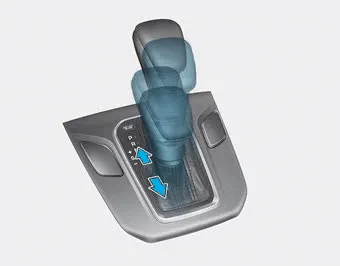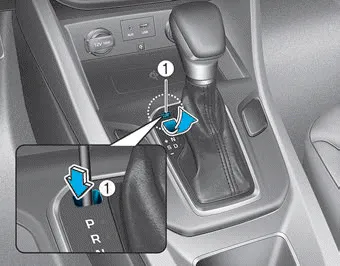Hyundai Ioniq (AE): Dual Clutch Transmission / Shift Lever Position
P (Park)
Always come to a complete stop before shifting into P (Park).
To shift from P (Park), you must depr ess firmly on the brake pedal and make sure your foot is off the accelerator pedal.
If you have done all of the above and still cannot shift the lever out of P (Park), see "Shift-Lock Release" in this section.
The shift lever must be in P (Park) before turning the vehicle off.
WARNING
- Shifting into P (Park) while the vehicle is in motion may cause you to lose control of the vehicle.
- After the vehicle has stopped, always make sure the shift lever is in P (Park), apply the parking brake, and turn the vehicle off.
- When parking on an incline, place the shift lever in Park and apply the parking brake to prevent the vehicle from rolling downhill.
- Do not use the P (Park) position in place of the parking brake.
R (Reverse)
Use this position to drive the vehicle backward.
NOTICE
Always come to a complete stop before shifting into or out of R (Reverse); you may damage the transmission if you shift into R (Reverse) while the vehicle is in motion.
N (Neutral)
The wheels and transmission are not engaged.
Always depress the brake pedal when you are shifting from N (Neutral) to another gear.
WARNING
Do not drive with the shift lever in N (Neutral). The engine brake will not work and lead to an accident.
WARNING
Do not shift into gear unless your foot is firmly on the brake pedal. Shifting into gear when the engine is running at high speed can cause the vehicle to move very rapidly. You could lose control of the vehicle and hit people or objects.
D (Drive)
This is the normal driving position. The transmission will automatically shift through a six-gear sequence, providing the best fuel economy and power.
For extra power when passing another vehicle or driving uphill depress the accelerator pedal further until you feel the transmission downshift to a lower gear.
CAUTION
Depress the brake pedal fully to prevent unintended movement when stopping the vehicle.
If you drive the vehicle with the shift lever in D (Drive), the vehicle will
automatically change to ECO mode. The  indicator will illuminate on the instrument cluster.
indicator will illuminate on the instrument cluster.
When driving in ECO mode, the vehicle improves fuel efficiency for ecofriendly driving.
S (Sport)
If you drive the vehicle with the shift lever in S (Sport), the vehicle will
automatically change to SPORT mode. The
 indicator will illuminate on the instrument
cluster.
indicator will illuminate on the instrument
cluster.
When driving in SPORT mode, the vehicle provides sporty but firm riding.
Information
In SPORT mode, the fuel efficiency may decrease.
Manual shift mode

Whether the vehicle is stationary or in motion, manual shift mode is selected by pushing the shift lever from the D (Drive) position into the manual gate. To return to D (Drive) range operation, push the shift lever back into the main gate.
In Manual Shift Mode, moving the shift lever backwards and forwards will allow you to select the desired range of gears for the current driving conditions.
+ (Up) : Push the lever forward once to shift up one gear.
- (Down) : Pull the lever backwards once to shift down one gear.
Information
- Only the six forward gears can be selected. To reverse or park the vehicle, move the shift lever to the R (Reverse) or P (Park) position as required.
- Downshifts are made automatically when the vehicle slows down. When the vehicle stops, 1st gear is automatically selected.
- When the engine rpm approaches the red zone the transmission will upshift automatically.
- If the driver presses the lever to + (Up) or - (Down) position, the transmission may not make the requested gear change if the next gear is outside of the allowable engine rpm range. The driver must execute upshifts in accordance with road conditions, taking care to keep the engine rpms below the red zone.
Shift-lock system
For your safety, the dual clutch transmission has a shift-lock system which prevents shifting the transmission from P (Park) into R (Reverse) unless the brake pedal is depressed.
To shift the transmission from P (Park) into R (Reverse):
1. Depress and hold the brake pedal.
2. Start the vehicle or place the Engine Start/Stop button in the ON position.
3. Move the shift lever.
Shift-lock release

If the shift lever cannot be moved from the P (Park) position into R (Reverse) position with the brake pedal depressed, continue depressing the brake, and then do the following:
1. Place the Engine Start/Stop button in the OFF position.
2. Apply the parking brake.
3. Carefully remove the cap (1) covering the shift-lock release access hole.
4. Insert a tool (e.g. flathead screwdriver) into the access hole and press down on the tool.
5. Move the shift lever.
6. Remove the tool from the shiftlock override access hole then install the cap.
If you need to use the shift-lock release, have your vehicle inspected by an authorized HYUNDAI dealer immediately.
Steep Grade This warning message is displayed when vehicle is driven slowly on a grade and the vehicle detects that the brake pedal is not applied. Driving up hills or on steep grades: To hold the vehicle on an incline use the foot brake or the parking brake.
The paddle shifter is functional when the shift lever is in the D (Drive) or S (Sport) position, or the manual shift mode. The paddle shifter will operate when the vehicle speed is more than 3 mph (5 km/h).
Other information:
Hyundai Ioniq (AE) 2017-2022 Service & Repair Manual: Parking Distance Warning (PDW) ON/OFF Switch. Repair procedures
Removal • Put on gloves to prevent hand injuries. • When removing with a flat-tip screwdriver or remover, wrap protective tape around the tools to prevent damage to components.
Hyundai Ioniq (AE) 2017-2022 Service & Repair Manual: Repair procedures
Removal1.Disconnect the negative (-) battery terminal.2.Remove the tailgate lid trim.(Refer to Body - "TailGate Lid Trim")3.Disconnect the Rear view camera connector (A).4.Remove the Rear view camera assembly after loosening the mounting screws.Installation1.
Categories
- Manuals Home
- Hyundai Ioniq Owners Manual
- Hyundai Ioniq Service Manual
- Engine Mounting. Components and components location
- Theft-alarm System
- Jump Starting
- New on site
- Most important about car
